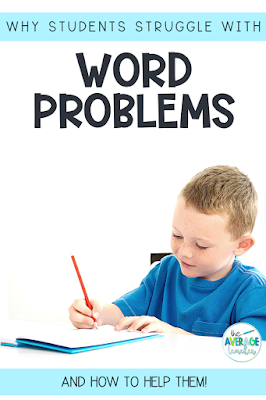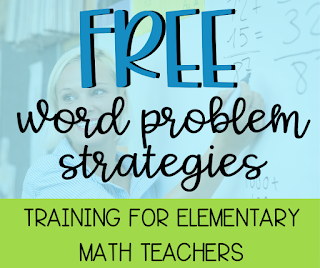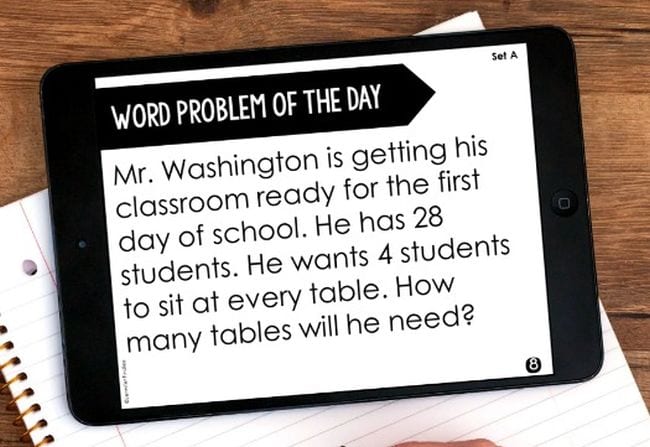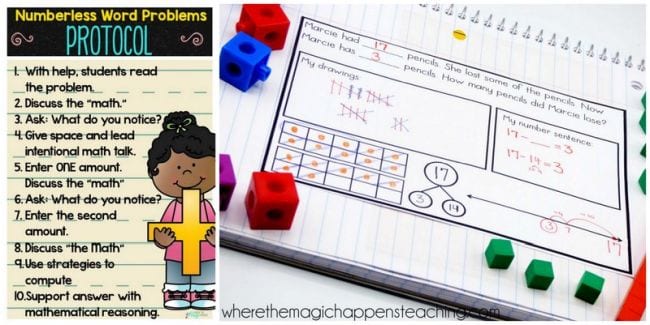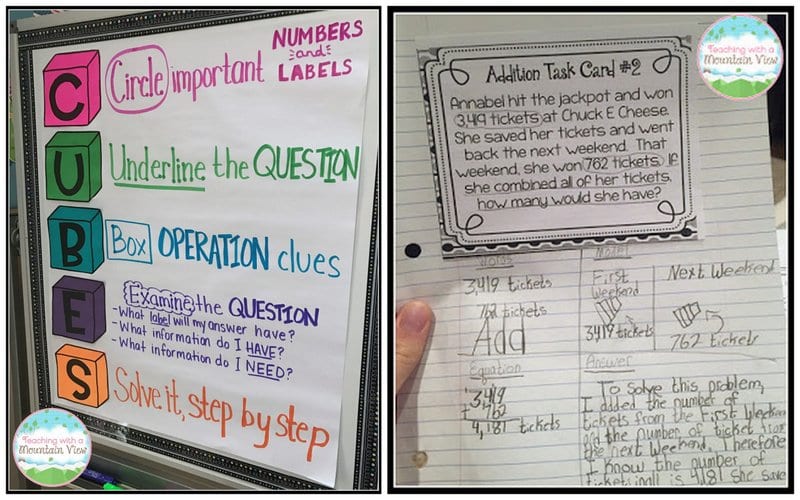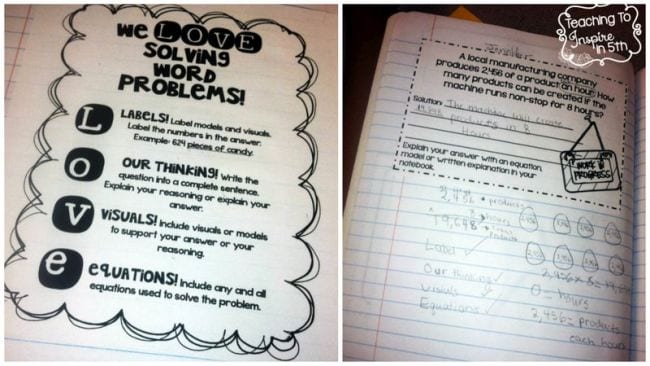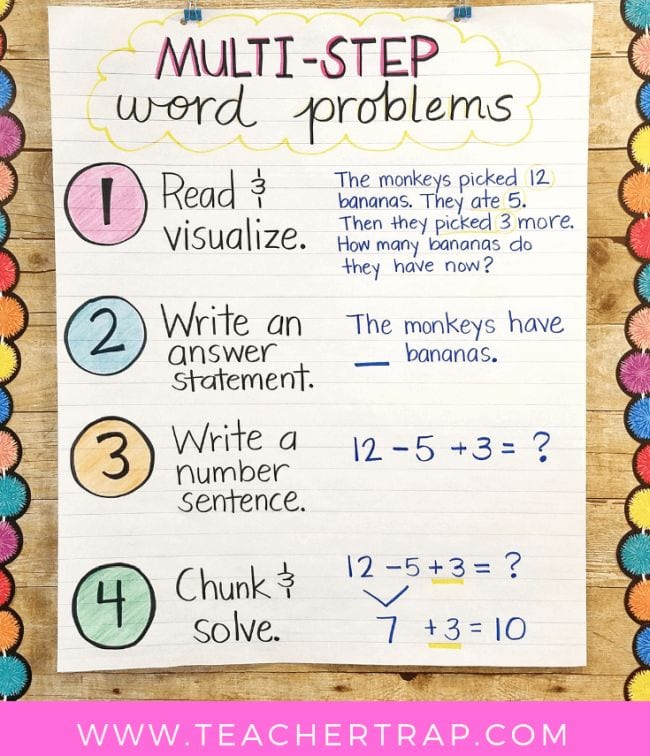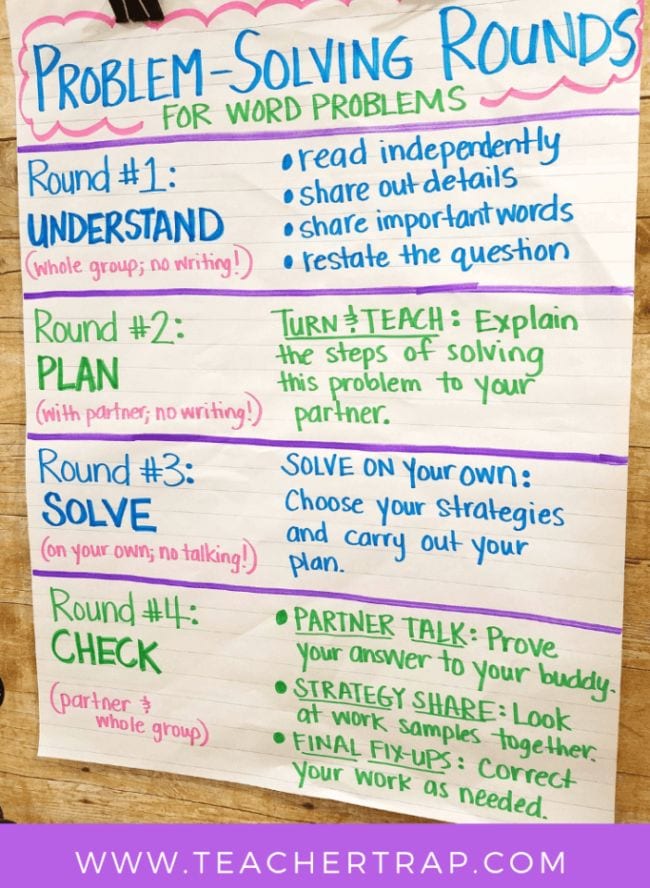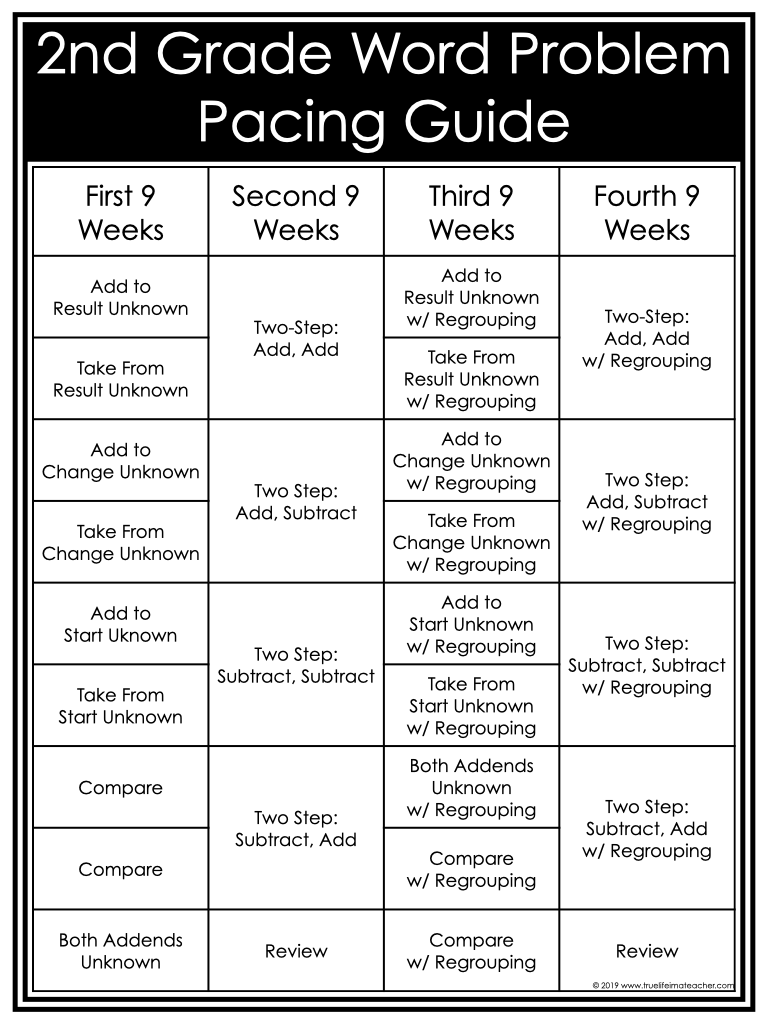Word problems are hard. Even I occasionally find myself stumped with figuring out how to correctly solve a word problem — so imagine how our students must feel sometimes!
There are many factors that contribute to why students often struggle with word problems. Fortunately, no student is a lost cause when it comes to this challenging skill. By recognizing why our students might be struggling, we can come up with a strategy to best help them.
Here are some of the common reasons why students have a hard time with word problems, and what you can do to help.
Problem #1: Reading Comprehension
One of the biggest reasons why some students struggle with word problems is because they aren’t just regular math problems — they involve reading! And more than that, students have to be able to fully comprehend what is happening in the problem in order to figure out how to solve it. Therefore, a lack of reading comprehension can play a huge part in a student’s ability to solve word problems.
How to Help
If you notice a student is struggling with word problems because of their reading comprehension, then focus on helping them to better understand what’s happening in the problem. The best way to do this will vary from student to student, but here are a few suggestions:
- Have the student draw a picture of what’s happening as they read it
- Use pictures or other visuals
- Act out the word problem
- Ask lots of questions while reading the problem to keep students focused
- Change the word problem to be more relevant to the student
Problem #2: Only Looking at the Numbers
One super common issue that all elementary math teachers have run into is that students often don’t actually stop to read the problem, but instead pull out the numbers and use a random operation. Unfortunately, this problem often occurs because of the way math textbooks are often designed. The word problems in a particular lesson, of course, have to do with that lesson. If I’m teaching a lesson on subtraction, students can assume that the word problems that follow are going to involve subtraction. This has unintentionally trained our students that they don’t need to actually read the problem — they just need to know the numbers. Of course, this presents an issue on tests that cover a variety of concepts.
How to Help
Two things can be done to help in this situation. First, students need to be in the habit of solving a variety of different types of word problems daily. We need to expose them to word problems regularly, but not that all use the same operation to solve. If your curriculum doesn’t already do this, add in a few practice problems each day to help diversify the types of problems your students are being exposed to.
Another thing you can do is use numberless word problems. That is, remove the numbers from the problems so students are first forced to pay attention to what’s happening. Discuss the problem without the numbers; then, when students are ready, add the numbers back in. This will help get students into the habit of reading the problem.
Problem #3: Tricky Language
One big problem I’ve found with word problems is that many curriculum and exam writers use tricky language, designed to trip students up. I have mixed feelings about this tactic; however the reality is, that’s the way it is! So, even if your students have great reading comprehension and fully understand how to solve a problem, they may still get misled by the wording of the problem and solve incorrectly.
How to Help
Unfortunately, there isn’t a whole lot you can do about the way problems are worded. However, there are still ways that you can help your students to not get tripped up. First, do NOT teach students that certain words indicate any specific operation. This is a practice that used to be commonly used, but textbook companies have caught on and now use that against us. If students have been taught that in the past, you may have some unteaching to do.
The language used is still important to pay attention to, we just don’t want students thinking that certain words ALWAYS mean something (such as «more» ALWAYS means addition. Sometimes, yes, but not always).
Teaching students to use the language instead to help them determine whether the numbers in the problem are a part or the whole is much more effective. For more information on this strategy, check out this post.
Word problems can be tricky, and if you have questions about the best practices to teach them effectively, I have a FREE video series going on right now you might be interested in! Click here to sign up for the free training now.
Comment below if you have any questions or tips for teaching word problems! I’d love to hear from you!
by Kayla @ The Average Teacher
Word problems can be tricky for a lot of students, but they’re incredibly important to master. After all, in the real world, most math is in the form of word problems. “If one gallon of paint covers 400 square feet, and my wall measures 34 feet by 8 feet, how many gallons do I need?” “This sweater costs $135, but it’s on sale for 35% off. So how much is that?” Here are the best teacher-tested ideas for helping kids get a handle on these problems.
1. Solve word problems regularly
This might be the most important tip of all. Word problems should be part of everyday math practice, especially for older kids. Whenever possible, use word problems every time you teach a new math skill. Even better: give students a daily word problem to solve so they’ll get comfortable with the process.
Learn more: Teaching With Jennifer Findlay
2. Teach problem-solving routines
There are a LOT of strategies out there for teaching kids how to solve word problems (keep reading to see some terrific examples). The important thing to remember is that what works for one student may not work for another. So introduce a basic routine like Plan-Solve-Check that every kid can use every time. You can expand on the Plan and Solve steps in a variety of ways, but this basic 3-step process ensures kids slow down and take their time.
Learn more: Word Problems Made Easy
3. Visualize or model the problem
Encourage students to think of word problems as an actual story or scenario. Try acting the problem out if possible, and draw pictures, diagrams, or models. Learn more about this method and get free printable templates at the link.
Learn more: Math Geek Mama
4. Make sure they identify the actual question
Educator Robert Kaplinsky asked 32 eighth grade students to answer this nonsensical word problem. Only 25% of them realized they didn’t have the right information to answer the actual question; the other 75% gave a variety of numerical answers that involved adding, subtracting, or dividing the two numbers. That tells us kids really need to be trained to identify the actual question being asked before they proceed.
Learn more: Robert Kaplinsky
5. Remove the numbers
It seems counterintuitive … math without numbers? But this word problem strategy really forces kids to slow down and examine the problem itself, without focusing on numbers at first. If the numbers were removed from the sheep/shepherd problem above, students would have no choice but to slow down and read more carefully, rather than plowing ahead without thinking.
Learn more: Where the Magic Happens Teaching
6. Try the CUBES method
This is a tried-and-true method for teaching word problems, and it’s really effective for kids who are prone to working too fast and missing details. By taking the time to circle, box, and underline important information, students are more likely to find the correct answer to the question actually being asked.
Learn more: Teaching With a Mountain View
7. Show word problems the LOVE
Here’s another fun acronym for tackling word problems: LOVE. Using this method, kids Label numbers and other key info, then explain Our thinking by writing the equation as a sentence. They use Visuals or models to help plan and list any and all Equations they’ll use.
Learn more: Teaching With Jennifer Findlay
8. Consider teaching word problem key words
This is one of those methods that some teachers love and others hate. Those who like it feel it offers kids a simple tool for making sense of words and how they relate to math. Others feel it’s outdated, and prefer to teach word problems using context and situations instead (see below). You might just consider this one more trick to keep in your toolbox for students who need it.
Learn more: Book Units Teacher
9. Determine the operation for the situation
Instead of (or in addition to) key words, have kids really analyze the situation presented to determine the right operation(s) to use. Some key words, like “total,” can be pretty vague. It’s worth taking the time to dig deeper into what the problem is really asking. Get a free printable chart and learn how to use this method at the link.
Learn more: Solving Word Problems With Jennifer Findlay
10. Differentiate word problems to build skills
Sometimes students get so distracted by numbers that look big or scary that they give up right off the bat. For those cases, try working your way up to the skill at hand. For instance, instead of jumping right to subtracting 4 digit numbers, make the numbers smaller to start. Each successive problem can be a little more difficult, but kids will see they can use the same method regardless of the numbers themselves.
Learn more: Differentiating Math
11. Ensure they can justify their answers
One of the quickest ways to find mistakes is to look closely at your answer and ensure it makes sense. If students can explain how they came to their conclusion, they’re much more likely to get the answer right. That’s why teachers have been asking students to “show their work” for decades now.
Learn more: Madly Learning
12. Write the answer in a sentence
When you think about it, this one makes so much sense. Word problems are presented in complete sentences, so the answers should be too. This helps students make certain they’re actually answering the question being asked… part of justifying their answer.
Learn more: Multi-Step Word Problems
13. Add rigor to your word problems
A smart way to help kids conquer word problems is to, well… give them better problems to conquer. A rich math word problem is accessible and feels real to students, like something that matters. It should allow for different ways to solve it and be open for discussion. A series of problems should be varied, using different operations and situations when possible, and even include multiple steps. Visit both of the links below for excellent tips on adding rigor to your math word problems.
Learn more: The Routty Math Teacher and Alyssa Teaches
14. Use a problem-solving rounds activity.
Put all those word problem strategies and skills together with this whole-class activity. Start by reading the problem as a group and sharing important information. Then, have students work with a partner to plan how they’ll solve it. In round three, kids use those plans to solve the problem individually. Finally, they share their answer and methods with their partner and the class. Be sure to recognize and respect all problem-solving strategies that lead to the correct answer.
Learn more: Teacher Trap
Like these word problem tips and tricks? Learn more about Why It’s Important to Honor All Math Strategies.
Plus, 60+ Awesome Websites For Teaching and Learning Math.
One of the toughest things about teaching fifth grade is definitely the word problems. By fifth grade, a lot of students have become so dependent on using key words that they no longer even read for meaning when they’re solving word problems. However, as fifth grade teachers know, key words only take the students so far.
I have read many articles and blog posts that are adamant against teaching key words, but many of them do not offer an alternative. About three years ago, I created a strategy for teaching my students to solve word problems that does not rely on key words, and I want to share it with you today.
What to Teach Instead of Key Words – Teach Situations
I really want my students to understand what the problem is asking them to do. Keeping this in mind, I teach word problems in terms of what the situation of the word problem is versus what key word is in the word problem.
Before I taught this strategy, many of my students read word problems in order to find the key words. They did not read to understand what the problem was really telling them or asking them.
To combat this, I teach them to think of word problems more as situations. When a student looks at a word problem from a situation standpoint, they are reading for meaning and really understanding what operation is required to solve the problem.
Introductory Lesson to Stop Relying on Key Words
To get students to stop relying on key words and think of situations instead, I do an introductory lesson involving four word problems (shown above).
Each of the word problems use the word total. However, the word problems each require a different operation.
When discussing the word problems, we always have a big discussion about how each of the word problems uses total but they are not all adding or even multiplying. This really gets the students to understand that key words alone cannot always be relied upon.
During this lesson, I stress the importance of really understanding the situation that the word problem is describing to figure out which operation to use. A link to download the printable of the four word problems I use will be available at the end of this post.
Solving Word Problems by Focusing on Situations
After teaching the lesson involving the four word problems, I move right into discussing different situations and how those situations can be translated through a word problem.
As a class, we discuss different situations and determine which operation would be used to solve the word problems that involve that situation.
Together, we create an anchor chart of different situations under the operation that would be used to solve the situation. We add to this anchor chart as the year progresses and the students are exposed to more word problems with varying situations (For example: taking part of a part when multiplying fractions).
I use the printable chart above to help me generate a list of situations to discuss with students. Many of the fraction situations I don’t introduce until later on in the year once we start fractions.
Speaking of fractions, when we really start digging into multiplication and division of fractions, I always have to revisit the idea of using situations to help solve word problems versus key words. The fifth grade level fraction word problems are really tricky and many of my students revert back to key words because they are overwhelmed. At this point, I typically give students the printable version of the chart for them to refer to on a daily basis as they solve word problems.
Moving away from key words and having students think about operations in terms of situations instead has made a huge difference in the way my students think about and solve word problems.
When they are solving a tricky word problem, I always remind them to revisit the situation chart and see which situation matches the word problem. This gets them away from relying solely on key words and builds their confidence with word problems. It also helps them be more successful when solving multi-part word problems. To read more about how I teach multi-part word problems, click here.
Download the FREE Word Problems without Key Words Printables Here!
You can download the word problems and the printable chart by clicking here on the image below.

P.S. If you are in need of word problems, click here to see the sets I have in my TeachersPayTeachers store.
I’m sure you have seen the keywords in word problems anchor chart that give students a list of math keywords to look for when solving word problems. You know the ones that say if you see words such as sum, all, or total then you add. Or if you see the words less, difference, or fewer then you subtract. Well this is an outdated strategy that should no longer be taught when teaching word problems. Let me explain why math key words are not the way to go and give you some new and different strategies to try.


Reason #1 To Not Use Keywords in Word Problems
First of all students need to practice critical thinking skills, especially in math. If we tell students to look for these subtraction keywords or addition keywords we are basically teaching them to not think through the problem to figure out what they need to do. It is an easy way for students to skim math word problems and look for specific words that tell them to add or subtract. Looking for word problem keywords will is not a great way to help students and it will definitely cause students to become weaker in math and comprehension.

Reason #2 To Not Use Keywords in Word Problems
Another reason this is not a good strategy is because many times there are not keywords in word problems. So, as mentioned above, students have been taught to skim for a keyword but if there is not one, they are left not knowing what to do because they haven’t been taught the proper way to analyze a math problem. There are many different types of word problems, so students cannot just scan for keywords.
Let me give you some examples.
14 grapes are in the basket. 6 are green and some are purple. How many are purple?
6 dogs are at the park. 4 more dogs come to the park. How many dogs are at the park now?
Both of these examples do not contain keywords that would tell students what to do in order to solve or which math operation they need to use. This would leave a lot of students stumped and frustrated.

Or look at this one. Some kids are at the playground. 4 kids leave and now there are 12 kids. How many kids are on the playground now? Some would argue that the word “leave” would tell us to subtract but in reality “leave” is not a keyword that would be taught so students would still be left not knowing.
If students only know to look for keywords then these types of problems would leave them confused because they don’t contain a keyword.
Some words in contextual problems can be misleading. Take a look at this problem. There are 4 buses. Each bus has 5 students. How many students are there in all? In all would tell you to add right? Leading students to believe this is an addition word problem. Well if we add we get 9 which is not the correct answer so the keyword strategy fails us there.
One more example. Maggie has 6 more crayons than Jake. Maggie has 10 crayons. How many crayons does Jake have? More would tell us to add, but if we add 10 + 6 we get 16 and that is not the right answer.
If No Keywords for Word Problems Then What?
So you might be wondering what is the right way to teach students to solve word problems to help them in the long run? Make sure to explicitly model how to analyze a problem and have students using manipulatives, drawings, work mats and organizers. Giving students a variety of strategies will help improve their problem solving skills.

Another suggestion would be to have students restate the word problem in their own words. This is one of my favorite strategies and ensures students really comprehend what the word problem is about and what it is asking them to do. It helps them understand the context of the word problem. This is a great strategy to use in small groups as an informal assessment.
My word problem lesson plan bundle is a great resource that will help you with all of this. It includes small group lesson plans that have students doing these exact things so they master solving subtraction word problems and addition word problems in no time. The best part about these lesson plans is they are differentiated to help you spend less time planning you math centers and activities!

If you want to read more about teaching students to solve word problems then make sure to read this blog post where I share fun and engaging ideas to use in your 1st grade classroom.
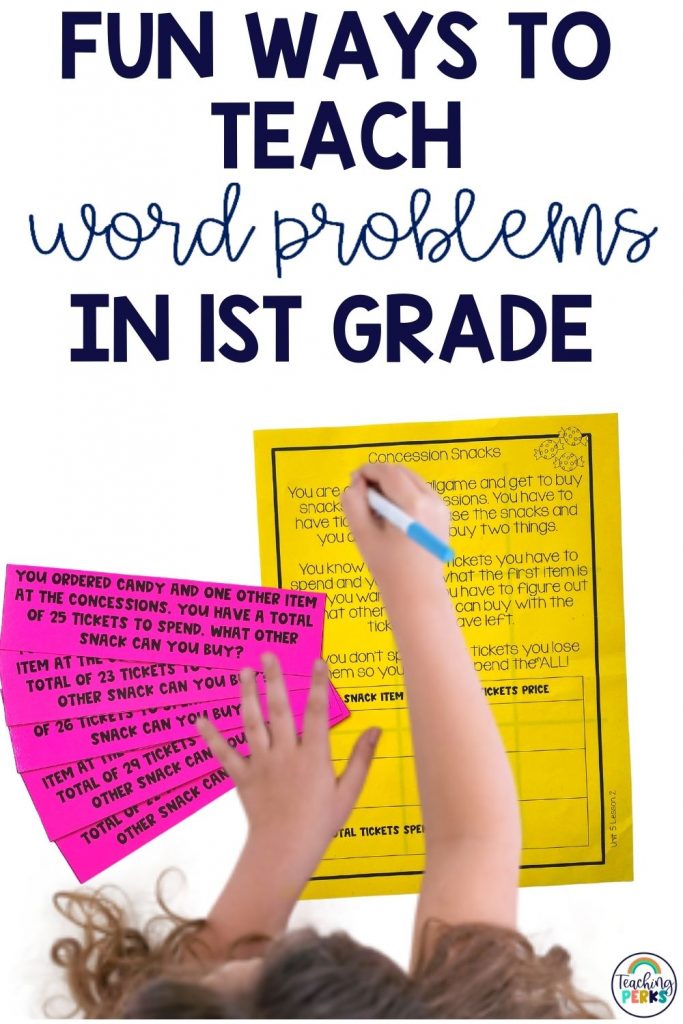
Ah, word problems. They are SO important for our students to understand, yet one of the most challenging parts of math instruction. Word problems are unique in that they are not JUST about math – they require reading comprehension, as well. Therefore, even students who excel at math can often struggle with word problems. As teachers, it can be difficult to know which word problem strategies to teach.
In this post, I am going to share some of the common strategies for teaching word problems and why they are or aren’t effective. I would also highly encourage you to check out this post, where I share ideas for reaching all your students in your word problem instruction.
Math Word Problem Solving Strategies
There are many word problem strategies out there, but some are more effective than others. Let’s take a look at some of the different strategies and whether or not they are beneficial.

Teaching Keywords in Word Problem Instruction
Growing up, many of us were probably told that certain words in story problems indicated a specific operation. For example, “more” means addition, “fewer” means subtraction, “each” means multiplication. And while often this is the case, sometimes it is not. For example, take the following problem:
Katie picked 4 apples fewer than Marvin. If Katie picked 12 apples, how many did Marvin pick?
In this problem, the word “fewer” is used. Normally this would indicate subtraction, but if you really look at what the question is asking, you will find that we actually need to add to solve. Because of this, the keyword strategy is not effective.
That being said, I personally believe the words and language used in a problem are still worth noting. The word “fewer” is still significant; the problem lies in assuming it automatically means subtraction. As a teacher, I always taught my students to pay attention to important words, but never taught them that certain words always mean a certain operation.
Instead of using the term “keywords,” I refer to them as “important words” or “context clues”. Because reading comprehension is a major part of solving word problems, we cannot entirely ignore the language used. I do think it’s worth taking the time to encourage students to look for certain words in problems, such as the words listed above. The important thing is that we do not tell them what to do with those words – only that they are important. More on this later, but I thought it was worth noting here.
Using Attack Strategies
Another common strategy for teaching word problems is what’s known as an attack strategy. Attack strategies involve a series of steps (or “plan of attack”) to follow when solving word problems. Common attack strategies include:
- RDW (Read the problem, Draw a model, Write the equation)
- CUBES (Circle the numbers, Underline the question, Box the keywords/context clues, Evaluate the problem, Solve & check)
- RUN (Read the problem, Underline the question, Name the problem type)
- FOPS (Find the problem, Organize information with a diagram, Plan to solve the problem, Solve the problem)

There are many more – these are just a few examples. Attack strategies can certainly be helpful when used correctly. They are easy to remember and give students a clear plan for solving. Many attack strategies use fun acronyms like the ones listed above; however even strategies that do not spell out words can still be effective.
These strategies are effective largely because they focus on reading and understanding the problem first, and then solving. As we all know, many students like to simply pull out the numbers and start doing math instead of actually taking the time to read the problem. Attack strategies help solve that issue.
Numberless Word Problems
In 2014, Brian Bushart popularized the idea of removing the numbers from word problems. This is to help students understand what is actually happening in the problem. He details the process in this blog post, which is a GREAT read and I highly recommend checking it out (once you’re done reading this one!).

In short, numberless word problems are effective because they cause students to take a step back and really look at what the problem is asking. Eventually, of course, you’ll want to add the numbers back in. But starting out with the numbers removed and engaging in a discussion of what is actually happening in the problem is an effective first step in gaining comprehension.
Schema-Based Instruction
Of all the word problem strategies out there, schema-based instruction is the one with the most research backing it. Schema-based instruction (or SBI) involves categorizing word problems into particular types, or schemas, which will help you determine how to solve the problem.
Schemas can be additive or multiplicative. There are 3 main additive schemas: combine, compare, and change. Combine problems involve putting together two or more numbers to find a total. Compare involves finding the greater set, lesser set, or the difference. In change problems, an amount either increases or decreases over time.

Likewise, there are also 3 main multiplicative schemas: equal groups, comparison, and proportions. Equal groups involves a unit or group being multiplied by a specific number to find a product. In comparison problems, a set is multiplied a number of times for a product. The proportions schema focuses on the relationships among quantities.

The idea behind schema-based instruction is that all word problems fit into one of these schemas. Each schema has a unique graphic organizer and process for solving a problem that fits that schema. SBI is often accompanied with an attack strategy – such as RUN, for example. Students will first Read the problem, then Underline the questions, and finally Name the problem type (schema) before solving. This last step of identifying the schema will help students understand how to solve the problem.
Part-Part-Whole Instruction
This isn’t really a strategy, per se. But, it is an important concept for students to understand in order to be successful with word problems. Understanding part-part-whole relationships is a critical aspect of number sense. My approach to teaching word problems involves a major emphasis on part-part-whole. Granted – I taught second grade, where word problems were mostly solved by addition and subtraction. Part-part-whole works with multiplication and division, too, but looks a little bit different.
My process for walking students through word problems always included having students identify whether each number represented a part or the whole, and which (a part or the whole) was missing. This was helpful because my students knew that a missing part means subtraction, and a missing whole means addition.

Identifying what each number represented is where the “keywords” I mentioned above come in. Words like “more,” “fewer,” and “each” – while they do NOT tell us how to solve – are important context clues to help us decide whether each number given is a part or the whole.
I used the CUBES attack strategy to go with this. However, instead of boxing “keywords,” we boxed “context clues”. Again, those words are still important – they just don’t tell us how to solve. The words are important because they tell us which numbers are greater or less than other numbers, or if a certain number represents a group. All are important things to know in determining the parts and the whole.
Once students identify what each number represents, they are able to solve. I’ve found that students who were correctly able to determine the parts and the whole in a word problem were VERY successful in finding the answer.

Free Training for Word Problem Strategies
Want to learn more about how to effectively teach word problems? I’m hosting a FREE video training series that you won’t want to miss! It’s launching THIS MONDAY, 9/21, so make sure you join the waitlist so you don’t miss out. Upon signing up, you will receive my free 30-page e-book for how to differentiate word problem instruction in your classroom. CLICK HERE TO JOIN THE WAITLIST, or sign up using the form below.
How do you teach word problems?


3-Step System
1. Read: Read the problem and decide what the question is asking.
- Read the problem 2 times or more.
- Underline or circle key words, phrases, and numbers. Draw a line through irrelevant information.
2. Plan: Think about what the story is asking you to do. What information are you given, and what do you need to find out?
- Draw a picture.
- Circle or underline key words. (Use highlighters or crayons to color-code key numbers and phrases.)
- Write out the question in your own words.
3. Solve: What strategy could you use to find the missing information: addition, subtraction, multiplication, or division?
- Write a number sentence and solve.
- Use counters.
- Create charts.
Check your work by explaining your reasoning. Does your answer make sense?
Download this free strategy checklist from Math Fundamentals to help your child solve word problems.
Different Strategies to Solve Word Problems
Everyone learns in a different way. What makes sense to one individual often isn’t the easiest option for another. Incorporating different strategies to solve word problems can help your child discover what strategy works best for him or her. A few tips to use are:
1. Circle numbers in a story and underline key phrases.
Color coding is a fun method to incorporate to help children decide what operation the question is asking for. Assign a color to each operation and highlight the phrase that identifies it. For example, red links to addition and blue links to subtraction.
2. Incorporate a key word list.
Key word lists are best used for teaching younger children how to solve word problems. As math curriculum advances, children should not be dependent on a key word list to solve a problem. The questions get trickier.
Addition
In all
Together
Total
Altogether
Combine
Sum
Join
Subtraction
Difference
Fewer
How many more
How much more
Left
Remain
Less
3. Visuals
If your child is a visual learner, drawing a picture or using counters can help him or her understand what the problem is asking. Use number lines, charts, or counters or draw a picture.
4. Write your own word problem.
Knowing what is needed to write a word problem is the first step in identifying key words to solve a story. Take turns writing your own word problems with your child and exchange them to solve.
5. Stay organized.
It is important to write clearly and keep work space neat so children can read and follow their own computations. Many children need a separate piece of paper to allow them enough space to solve and understand their answer. Graphing paper is a great option to help students record neat work.
Download this free sample word problem from Math Fundamentals, grade 1.
How to solve a two-step word problem
In a two-step word problem children are being asking to solve two related equations. These can get tricky for children to understand when they transition from one-step to two-step problems. Help your child understand his or her relationships within two-step word problems with these strategies:
1. Circle important information.
Circle numbers and important phrases that ask questions. The number sentences needed to solve these equations are hidden in those asking questions. Identify the first and second questions needed to solve.
2. Distinguish the two parts of the problem.
First identify the first step of the first part of the word problem. Write a number sentence and solve.
3. Use the answer from the first-step solution to the whole problem.
Use the answer from the first question to help you solve the next equation. What operation does the second question require?
Check your work by explaining your reasoning. What was the question answered? Is the answer reasonable for the question being asked?
Download this free sample two-strategy word problem from Math Fundamentals, grade 2
Download this free sample multi-strategy word problem from Math Fundamentals, grade 4
Evan-Moor’s Math Fundamentals is a great resource for training students how to solve word problems in 3 simple steps. It provides step-by-step directions for solving questions and guides children with helpful visuals and key phrases.
Check out Daily Word Problems for consistent practice solving word problems.
For more fun math tips and strategies check out our Math- Ideas, Activities and Lessons Pinterest Board.
Save these tips and Pin It now!

Word problems can be a challenge to teach. Perhaps, it is because we are trying to teach students to problem solve: think about, observe, investigate, and reason through situations. Which, in my opinion, is quite the task! In today’s episode, Noelle discusses why problem solving is so important for our students and provides some strategies to get students thinking.

LISTEN ON: APPLE PODCAST | SPOTIFY
Problem Solving with Word Problems
In the book The Young Child and Mathematics, Juanita Copley states that problem solving happens through “doing, talking, reflecting, discussing, observing, investigating, listening, and reasoning.”
We can often mistake different methods for decoding word problems as problem solving skills. R.U.B.I.E.S. and C.U.B.E.S. and all of the acronyms where students are supposed to underline, box, or circle may feel productive, but they cannot produce the skills needed to solve real-world problems.
Why Are Word Problems so Difficult
There are a lot of different factors that play into this challenge and it could be a single isolated one or it could be a combination of several factors.
- Need for perseverance – some students can routinely go through all of the procedures involved in solving a math problem, but they haven’t yet acquired the perseverance needed to reason through a real life situation
- Reading skills — tasks and real world applications require reading comprehension and decoding skills to fully understand the situation and apply the mathematical reasoning skills necessary to solve
- Multiple steps — requires students to create a plan with several steps and work through the plan
- Incorrect vocabulary usage — sometimes students have been instructed to primarily look for specific words like “per” “of” “each” “sum”…and then they attempt to apply the operation — but we know that doesn’t always work and can also over simplify the process.
Shift the Focus from the Answer
This post and video from Phil Daro (co-author of the CCSS) says that based on their studies, teachers need to shift the focus from answer-getting to sense-making. “When the answer is the only goal, genuine learning is undermined.”
He says that teachers put too much emphasis on the answers; answers are part of the process, but they are not the only learning outcome. That wrong answers are part of the learning outcome.
- What if you framed wrong “answers” as “discoveries”? If students reached a wrong answer, you talked more about why that approach doesn’t work instead of how to get the right answer.
- What if you gave students the answers before solving, removing some of its power and instead spent class time figuring out different ways to get to the answer?
The goal of solving math problems is the critical thinking that happens along the way. Not the answer.
How do we teach problem solving?
Learning is not necessarily the solution to a specific question. We want students to apply sense-making to the rest of their lives.
I really want you to watch the video, but one of Daro’s suggestions is to provide students the correct answer before having students solve. It removes some of the power of finding the right answer, and puts an emphasis on figuring out different ways to get the answer. There are so many different ways to solve problems and it encourages students to think in this way.
Tip #1 – Allow flexibility in how students solve problems. Showing your work is said so often that it can seem meaningless to a student. Give students options for ways they can show their work. Here are a few examples:
Write an equation
Solve a simpler problem
Draw a picture
Draw a graph
Use manipulatives
Guess and check
Use logical reasoning
Make a table
Tip #2- Focus on quality over quantity. Quality over quantity is going to mean different things for different teachers, depending on the number of students, the length of your class period and even the different concepts being covered. Here is one example for helping students focus on “sense-making” in a problem.
Let’s take this pretty basic word problem >> Mr. Roy overdrafts his account by $25.50 and then is charged a $10.35 fee by the bank. What is the change in Mr. Roy’s bank account?
Before modeling a think-aloud to discuss how to solve this problem, ask so many questions that students will have no choice but to THINK about what the problem is asking for. Shift the workload to the students. Here are a few I brainstormed:
- Who is Mr. Roy?
- What is an overdraft?
- Is a fee a good thing or bad thing? For who?
- Why is Mr. Roy charged a fee?
- What is the change measuring?
- Does he have more money or less money?
I just asked 6 questions and haven’t even gotten to the math yet! Model for students the type of critical thinking and questioning you want students to use when they are solving solo.
Then have students just try out the problem. Circulate to see the different methods. Come together to discuss the different ways you saw the problem solved.
Bring this problem to life by providing Monopoly money to students to “act” it out.
I love seeing students be problem solvers and I think it is such a lifelong skill that they will always carry with them. In fact, they may not frequently need to calculate the equation of a line or the probability of a compound event, but each and everyday they will use their “sense-making skills” to solve problems and make decisions.
If you want to focus on teaching problem solving and not writing or finding word problems, then All Access may be right for you!

I’ve never really enjoyed teaching word problems. I mean, they can be so stinkin’ difficult to get and let’s face it, they just aren’t fun to teach. I can never find enough word problems that are written in a way that will cover the standards I need to address, or the wording is just all off. So, I’m not gonna lie… solving word problems hasn’t always been a top priority of mine in the classroom. We do them, but I tend to hold my students’ hands for far too long because I’m scared they will fail when working independently. But, this year, I’ve noticed that my kids aren’t going to fail… they may not get it the first time, but if given the right tools they will get it eventually… maybe not every word problem they tackle, but the tools give them a means to at least get started.
So, after needing word problems for literally FIVE years, I decided to make a pack designed just for my kiddos. Does it cover every single standard? NO! But, I have taken five concepts to start with, and hope to continue doing packs like this in the future to cover even more word problem types that address a variety of skills. I had to start somewhere 🙂 So, let’s take a closer look at what I’ve included:
Each concept: Basic Addition, Basic Subtraction, Word Problems with Extra Info, Regrouping, and Multi-Step Word Problems has TEN word problems. So, that’s 50 pages that look like the ones below. Print out the amount of pages you need for your class, cut into strips, and let your students glue into their math spirals OR onto scratch paper to solve.
Each concept also has a Scoot with EIGHT additional word problems. So, that’s NINETY different word problems in all. If you wanted to mix operations, you could take a couple problems from each category and spread them around the room, like shown below. Or, just focus on one operation at a time like you’ll see in a minute!
Below you will see how each concept is broken down. I’ve also included examples of the problems that we glue into our math spirals. My way of solving problems may not be your cup of tea. That’s what I love about this pack… I don’t tell you how to teach problem solving, I just give you some tools to implement in your classroom. You can still teach the steps the way your school or district requires… or maybe the way that you’ve found successful in the past. You’ll also see posters that I’ve included throughout the pack… resources to help drive those skills home!
For each concept, I did try to include a variety of difficulty levels and I worded each one very differently so that my students have exposure to a number of problems. I took into account what I thought they could do independently, and then tried to stretch it a little further. I always like my kids to show their work/thinking because it helps me see what’s going on in their sweet little brains! Of course, that takes quite a bit of modeling at first, but once you get the ball rolling they will take off and surprise you!
If you’re looking for a better way to teach word problems, and more importantly, want your students to be more successful in solving word problems, I’m here to help. Teaching word problems in 2nd grade doesn’t have to be a challenge.
Why is teaching word problems in 2nd grade so hard?
When I first started teaching, I taught my students to use keywords, underline and circle, highlight and box…and yet, it didn’t help. They still didn’t know when to add and when to subtract.
And, my students didn’t understand or perform any better.
It didn’t help that I wasn’t consistently teaching or letting my students practice solving word problems.
Word problems have always been a source of contention for my students no matter what grade I taught (1st, 2nd, and 4th), and have always been something I’ve taught haphazardly as part of an adopted math curriculum.
Most math curriculums offer the following:
- 1 or 2 word problems at the end of each lesson, but don’t actually offer a way to teach students how to solve word problems
- 1 chapter on “problem solving”
And seriously, neither of those is helpful.
I wanted my students to get daily, strategic word problem practice.
And guess what? When I started teaching word problems in 2nd grade in a consistent, strategic way, my students were less frustrated, and much more proficient word problem solvers.
So, what’s the solution?
Now, I follow a 4-day teaching plan, and assess on day 5.
I no longer teach key words or underlining, circling, highlighting, and/or boxing…instead, I teach my students to look for patterns in how word problems are structured…word problem situations.
In addition, I dedicate 5-10 minutes each day for word problem teaching and practicing.
How do I know what to teach?
I start with the standard.
Honestly, no matter what I’m teaching this is where I start. I need to know exactly what the expectation is, so then I can help my students master it.
The Common Core standard for 2nd grade says:
CCSS.MATH.CONTENT.2.OA.A.1
- Use addition and subtraction within 100 to solve one- and two-step word problems involving situations of adding to, taking from, putting together, taking apart, and comparing, with unknowns in all positions, e.g., by using drawings and equations with a symbol for the unknown number to represent the problem.
While many states no longer use the term “Common Core” many of their adopted standards are the same, or at least similar.
MAFS.2.OA.1.1 (Florida Standards)
- Use addition and subtraction within 100 to solve one- and two-step word problems involving situations of adding to, taking from, putting together, taking apart, and comparing, with unknowns in all positions, e.g., by using drawings and equations with a symbol for the unknown number to represent the problem.
So here’s what 2nd graders need to be able to solve:
- Addition/Subtraction within 100
- One-Step & Two-Step
- Add to
- Take from
- Put Together
- Take Apart
- Compare
When you look at what 2nd graders are supposed to do, it’s no wonder teaching word problems is so difficult, not to mention students actually getting the hang of them.
How I teach word problems in 2nd grade:
At the beginning of the year, students are introduced to our word problem routine after the first couple of weeks of school.
I explain that word problems are like stories we have to read, and understand what’s going on in the story. We call these word problem situations.
Then, I teach students that there are 4 things they should always do when they solve a word problem:
- Write a Number Sentence
- Use a Strategy to solve
- I explain to students that I can’t hop inside their brains to see what they’re thinking, and if I don’t know what they’re thinking, I can’t help them become better word problem solvers.
- Students can draw a picture, use a fact family, base 10 blocks, and/or the standard algorithm.
- Computation
- I look to see that the student has the correct answer.
- Answer in a Sentence
- For example, instead of just saying “4,” my students write, “Cheyenne has 4 dogs.” This is important to connect math and writing, but also helps students check to see if their answer actually answers the question asked in the word problem.
Launching the word problem routine is all about modeling and routine. It doesn’t take long for students to get the hang of it.
I’ve done the hard work for you – I have 2nd grade word problems for the entire year, ready for you!
What’s the 2nd grade word problem routine?
On Mondays, I introduce the word problem situation. I find it helpful to have students “act out” the situation. Use the example on the situation poster/anchor chart to show students the pattern. (I teach students that the underlined portions of the number sentence are pieces we know, while the square represents the unknown.)
Model and solve the practice word problem, and provide feedback to students.
For the next 3 days, we model and solve a word problem that has the same situation as Monday. So we’re not skipping around. This is very systematic.
Finally, on Fridays, students complete 2 word problems on their own following the same situation we’ve used all week.
For differentiation or extension, students can write a word problem on the back of their assessment that follows the same situation they learned that week. This is such a great way to see if students really understand the situation we learned that week.
You might also like:
- Books to Teach the Importance of Listening
- Positive Classroom Management
- How to Display Student Work
- The First Day of School
Let’s connect!
Instagram // Pinterest // Facebook // Teachers Pay Teachers

